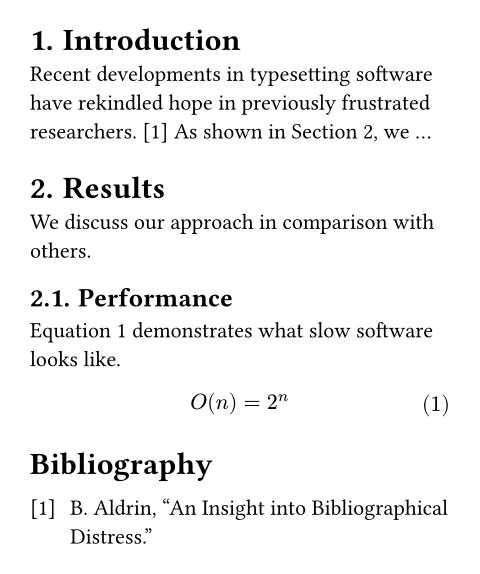refElement
A reference to a label or bibliography.
Produces a textual reference to a label. For example, a reference to a heading will yield an appropriate string such as "Section 1" for a reference to the first heading. The references are also links to the respective element. Reference syntax can also be used to cite from a bibliography.
Referenceable elements include headings, figures, equations, and footnotes. To create a custom referenceable element like a theorem, you can create a figure of a custom kind and write a show rule for it. In the future, there might be a more direct way to define a custom referenceable element.
If you just want to link to a labelled element and not get an automatic textual reference, consider using the link function instead.
Example
#set heading(numbering: "1.")
#set math.equation(numbering: "(1)")
= Introduction <intro>
Recent developments in
typesetting software have
rekindled hope in previously
frustrated researchers. @distress
As shown in @results, we ...
= Results <results>
We discuss our approach in
comparison with others.
== Performance <perf>
@slow demonstrates what slow
software looks like.
$ O(n) = 2^n $ <slow>
#bibliography("works.bib")

Syntax
This function also has dedicated syntax: A reference to a label can be created by typing an @ followed by the name of the label (e.g. = Introduction <intro> can be referenced by typing @intro).
To customize the supplement, add content in square brackets after the reference: @intro[Chapter].
Customization
If you write a show rule for references, you can access the referenced element through the element field of the reference. The element may be none even if it exists if Typst hasn't discovered it yet, so you always need to handle that case in your code.
#set heading(numbering: "1.")
#set math.equation(numbering: "(1)")
#show ref: it => {
let eq = math.equation
let el = it.element
if el != none and el.func() == eq {
// Override equation references.
numbering(
el.numbering,
..counter(eq).at(el.location())
)
} else {
// Other references as usual.
it
}
}
= Beginnings <beginning>
In @beginning we prove @pythagoras.
$ a^2 + b^2 = c^2 $ <pythagoras>

Parameters
target
The target label that should be referenced.
Can be a label that is defined in the document or an entry from the bibliography.
supplement
A supplement for the reference.
For references to headings or figures, this is added before the referenced number. For citations, this can be used to add a page number.
If a function is specified, it is passed the referenced element and should return content.
Default: auto
 View example
View example
#set heading(numbering: "1.")
#set ref(supplement: it => {
if it.func() == heading {
"Chapter"
} else {
"Thing"
}
})
= Introduction <intro>
In @intro, we see how to turn
Sections into Chapters. And
in @intro[Part], it is done
manually.
